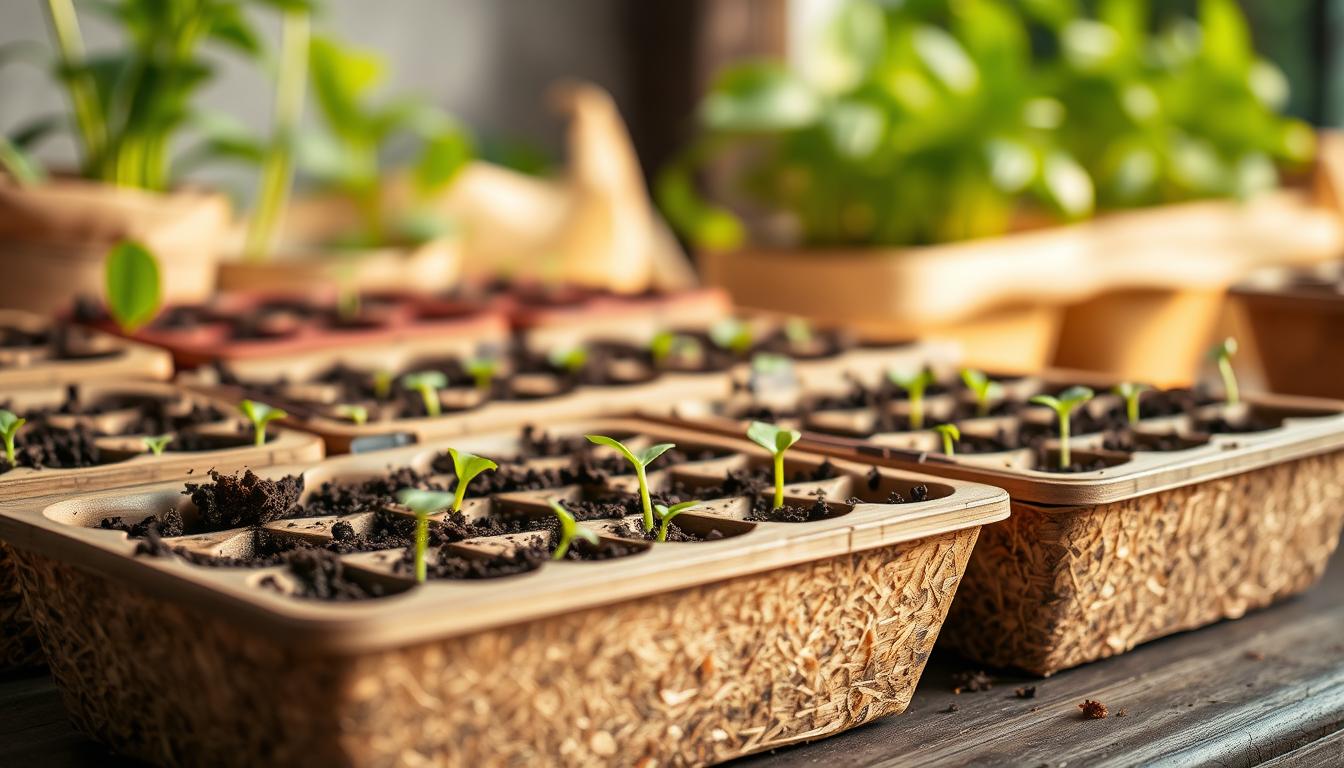Our garden choices go beyond picking veggies or flowers. Every tool and container we use affects our environment. Now, gardeners are focusing on eco-friendly seed starting trays as a key to sustainability.
Old plastic trays can stay in landfills for decades, adding to pollution. But, there’s a positive change. New, eco-friendly options are available. They’re both useful and good for the planet, showing we can do well without sacrificing quality.
Whether you garden for fun or make a living from it, choosing green materials is important. It’s a big step in taking care of our planet. By changing how we start seeds, we help both our gardens and the Earth.
The Environmental Impact of Traditional Seed Trays
Traditional seed trays are a big problem for our environment. They harm the very ecosystems we try to protect. Every spring, we fill our spaces with seedlings, but we often ignore the plastic trays they come in.
These trays are made from non-renewable plastics. Their creation uses a lot of energy and releases harmful gases. This makes the case for eco-friendly seed trays very strong.
The Plastic Problem in Gardening
The gardening world loves plastic too much. It’s in everything from pots to tools. This love for plastic is a big problem for our planet.
Our gardening habits are really bad for the environment. The horticulture industry throws away 500 million pounds of plastic every year in the U.S. Home gardeners add to this by throwing away 10-15 plastic trays each season.
Single-use trays are a big part of this problem. They only last one season before they break and are thrown away.
| Plastic Garden Item | Annual U.S. Consumption | Average Lifespan | Recycling Rate |
|---|---|---|---|
| Seed Starting Trays | 120 million units | 1-2 seasons | Less than 10% |
| Plastic Plant Pots | 350 million units | 2-3 seasons | About 15% |
| Plant Labels/Markers | 800 million units | 1 season | Less than 5% |
| Garden Tool Handles | 45 million units | 3-5 years | About 20% |
Chemical Leaching Concerns
Traditional seed trays also have chemical risks. They can leach harmful substances into the soil. This is a big problem for plants and our food.
These chemicals can get into plants and food. This is why many gardeners choose plastic-free options to avoid these risks.
Landfill Contributions from Garden Plastics
Most garden plastics end up in landfills. They can’t be recycled because they’re special. This is a big problem for gardeners who care about the environment.
Plastic waste from gardening gets worse in the spring and fall. This adds to the already big problem of waste management.
Decomposition Timeframes
Plastic seed trays last a very long time in landfills. It takes 500 years for them to break down. They don’t really decompose, but get smaller instead.
These small pieces of plastic are a big problem for our environment. Eco-friendly trays can break down in just one season when composted.
Wildlife Impact
Plastic waste from gardening harms wildlife in many ways. Birds use plastic in their nests, which can hurt their babies. Fish think plastic is food and can get sick from it.
Even the creatures in the soil are affected. Worms and other helpful organisms can get hurt by plastic. This is a big problem for our gardens.
Changing to plastic-free seed starters is a good idea. It helps our environment and lets us enjoy growing plants from seed.
Understanding Eco-friendly Seed Starting Trays
Eco-friendly seed starting trays blend science, care for the environment, and gardening solutions. They are made to be better for our planet, from start to finish. This includes the materials used, how they’re made, and how they break down.
These trays are different from plastic ones because they aim to harm the environment less. They’re often made from things that grow back, like plants. They use less energy to make and can easily be broken down or composted.
These trays are good for the planet in many ways. They think about how they get to you, the packaging, and the company’s values. This lets gardeners feel good about starting their seeds.
Sustainable Materials Used
The heart of any eco-friendly seed tray is its material. Today’s gardening supplies use new, green materials. These materials work well and are kind to our planet.
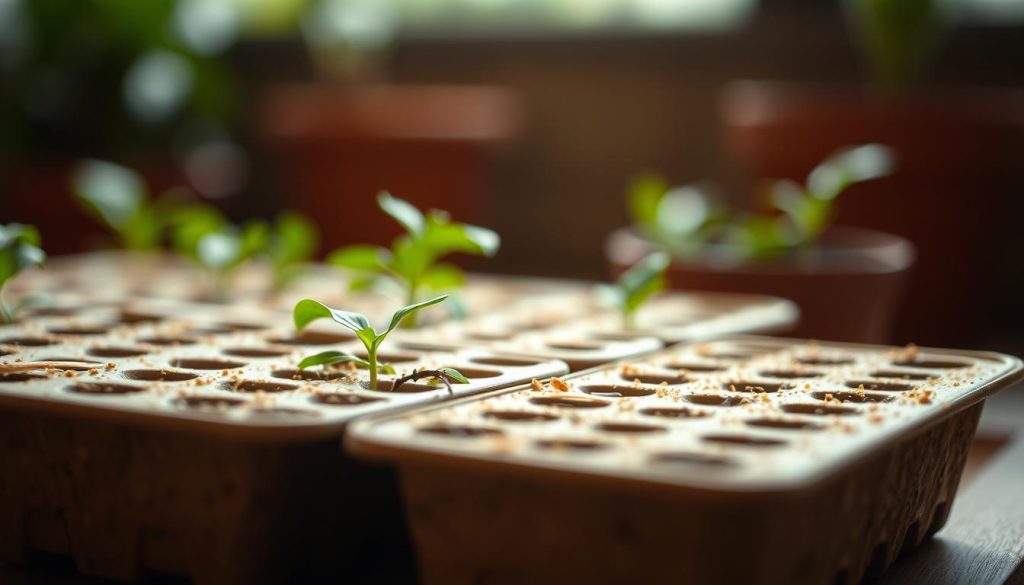
Plant-based trays are very popular. They turn old plant waste into useful gardening tools. This helps farmers and gardeners in a big way.
Coconut coir, from coconut husks, holds water and air for seeds. Rice hulls, from rice, make strong, light trays that break down in soil. Other options include trays from wheat straw, bamboo, and even mushroom mycelium.
Mineral-Based Alternatives
For those wanting something more lasting but still green, mineral trays are a great choice. They use natural materials that go back into the earth without harm.
Soil or peat blocks make their own trays, cutting out the need for extra ones. Clay trays are strong and break down into soil. Some trays are even made from calcium carbonate, like eggshells, for extra protection.
Production Processes and Environmental Footprint
The good stuff about eco-friendly trays goes beyond their materials. Making them uses less energy than plastic trays.
Energy Consumption Comparison
Plastic trays need a lot of energy and oil to make. Eco-friendly trays use much less energy. They’re made at lower temperatures.
Studies show biodegradable trays use 65% less energy than plastic ones. Companies like CowPots use composting waste heat to cut energy use even more.
Water Usage in Manufacturing
Water saving is another big plus of eco-friendly trays. Many makers use water over and over again. This cuts down on water waste.
Some top companies have cut their water use by over 80%. For example, Western Pulp Products uses recycled paper pulp with very little water needed.
| Material Type | Water Usage (Gallons/Unit) | Energy Consumption (kWh/Unit) | Biodegradability | Typical Lifespan |
|---|---|---|---|---|
| Traditional Plastic | 3.2 | 1.8 | No (500+ years) | 3-5 seasons |
| Coconut Coir | 0.8 | 0.4 | Yes (1-2 years) | 1 season |
| Rice Hull | 0.6 | 0.5 | Yes (3-6 months) | 1 season |
| Compressed Soil | 0.3 | 0.2 | Yes (immediate) | 1 season |
| Recycled Paper | 1.1 | 0.7 | Yes (2-5 months) | 1 season |
Types of Biodegradable Seed Trays
Today, gardeners can choose from many biodegradable seed trays. These trays are good for plants and the planet. They replace traditional plastic containers, reducing waste and helping seedlings grow better.
Fiber-Based Options
Fiber-based seed trays are very popular. They use plant fibers to make strong, compostable containers. These trays break down naturally after use.
Coconut Coir Trays
Coconut coir trays are made from coconut byproducts. They are very durable and hold water well. Coconut coir also fights off diseases that harm seedlings.
These trays last one growing season. Then, you can put them in the soil. They will break down and enrich the soil.
Rice hull containers are made from rice waste. They are light but strong. They drain well and keep moisture for seedlings.
They last 4-6 months before they start to break down. They’re great for plants that like dry soil.
Compostable Growing Containers
New materials are changing the seed starting world. These containers break down in home compost systems. They leave no harmful residues.
Cornstarch-Based Products
Cornstarch-based seed trays are a big step forward. They are made from PLA, a material from renewable corn. They look and feel like plastic but are eco-friendly.
They last a growing season but break down in 3-6 months in compost. They’re perfect for seedlings that need steady moisture.
Mushroom Mycelium Trays
Mushroom technology has created amazing seed trays. These trays are grown, not made. They use agricultural waste as a base.
They break down quickly in soil, usually in 30-45 days. As they decompose, they add nutrients to the soil, helping young plants grow.
Recycled Plant Pots
Recycled plant pots are another green choice. They give old materials a new life. They’re not biodegradable but are better than new plastic.
Post-Consumer Plastic Options
Some trays are made from recycled plastic. They use plastic waste and reduce landfill use. They’re not biodegradable but can last many seasons with care.
Look for trays made from 100% recycled content. They should also be UV-resistant for longer life. They can last 5-10 years with proper care.
Upcycled Material Innovations
Now, seed trays are made from industrial waste. Materials like recycled paper, textile scraps, and coffee grounds are used. These trays offer unique benefits as they break down.
They vary in durability and how fast they decompose. Some retain water better, while others release nutrients slowly.
| Tray Type | Material Source | Typical Lifespan | Best Uses | Special Benefits |
|---|---|---|---|---|
| Coconut Coir | Coconut processing byproduct | 1 growing season | Moisture-loving seedlings | Natural antifungal properties |
| Rice Hull | Agricultural waste | 4-6 months | Plants preferring drier conditions | Excellent drainage |
| Cornstarch/PLA | Renewable corn resources | 3-6 months in compost | Delicate seedlings | Plastic-like durability, fully compostable |
| Mushroom Mycelium | Agricultural waste + fungal growth | 30-45 days after planting | Direct transplanting | Adds nutrients to soil as it decomposes |
| Recycled Plastic | Post-consumer waste | 5-10 years | Long-term reuse applications | Diverts plastic from landfills |
Benefits of Using Eco-friendly Seed Starting Trays
Choosing eco-friendly seed starting trays brings many benefits. They help the environment and your plants. These trays are a great choice for those who care about the planet and their plants.
They reduce your carbon footprint and make your seedlings healthier. Switching to these trays is good for many reasons.
Environmental Advantages
Eco-friendly seed starting trays have a positive impact on the environment. They are made differently than plastic trays and last longer in nature.
Reduced Carbon Footprint
These trays lower your carbon footprint in several ways:
- They use 65-80% less energy to make than plastic trays
- Materials like coconut coir absorb carbon during growth
- They are often made locally, cutting down on emissions from shipping
- Being lighter, they also use less fuel during transport
Switching to biodegradable trays can cut your carbon emissions by up to 40%. This helps fight climate change with every seed you plant.
Waste Stream Reduction
The biggest benefit is at the end of the growing cycle. Eco-friendly trays don’t add to the waste problem like plastic does:
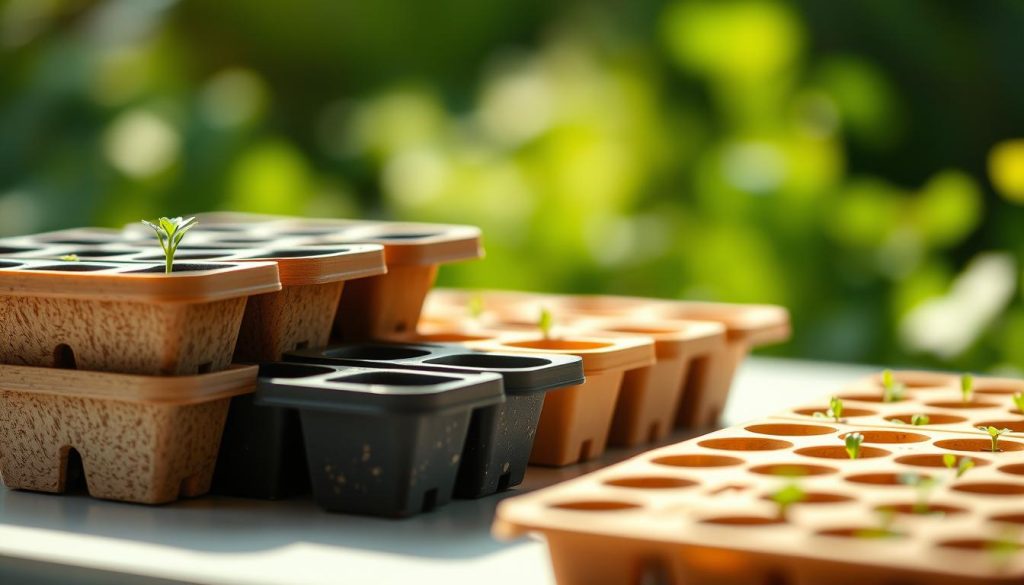
Biodegradable trays turn into compost, enriching the soil. Reusable options like bamboo or recycled plastic also end their life cycle in a better way. Many makers offer programs to take back their products, keeping materials in a loop.
Plant Health Benefits
Eco-friendly seed starting trays also benefit your plants. They offer growing conditions that plastic can’t match.
Root Development Improvements
The structure of eco-friendly trays helps roots grow better. This is due to:
- Improved aeration that prevents waterlogging and root rot
- Natural porosity that helps roots sense air and grow straight
- Microorganisms in some materials that boost root growth
- Biodegradable walls that don’t restrict root growth
For example, coconut coir trays have hormones that increase root mass by up to 20%. This gives seedlings a strong start and helps them handle stress better.
Transplant Success Rates
Transplanting is easier with biodegradable containers. Plants experience less shock because the whole container can go straight into the soil.
This method keeps the roots intact. Studies show transplant success rates go up by 30-40% with plantable containers. The walls of biodegradable trays break down, letting roots grow freely without disruption.
This means your plants will be stronger, grow faster, and have fewer transplant failures. It also saves seeds, time, and resources. Eco-friendly trays make gardening more sustainable.
Popular Organic Seed Starter Options
Exploring organic seed starters shows a wide range of earth-friendly products. These products help plants start strong and healthy. As more people want to garden sustainably, many options are now available.
Peat-Free Alternatives
More gardeners are choosing peat-free options. This is because peat bogs are important for the environment.
Wood Pulp Products
Wood pulp seed starters, like CowPots and Jiffy’s Forestry Pellets, hold water well. They’re made from wood or recycled materials. Prices are $5-$12, and you can find them online or at garden stores.
Hemp-Based Containers
Hemp seed starter pots are made from hemp, a fast-growing crop. Hemp needs little water and no pesticides. These pots cost $8-$15 and help plants grow well.
Paper-Based Seed Starters
Paper-based options are great for those who want to use less plastic. They’re made from recycled materials.
Molded Pulp Trays
Molded pulp trays, like those from EcoForms, look like egg cartons but are for seedlings. They cost $3-$7 and can be composted. They’re good for starting seeds and easy to transplant.
Newspaper-Derived Products
Products like PaperPot makers use waste paper for gardening. They’re biodegradable and don’t shock plants when planted. You can also make your own using newspaper and a wooden mold, which is very cheap.
Biodegradable Pots
Biodegradable pots let you plant seeds directly in the garden. This means no disturbing the roots.
Cow Manure Pots
CowPots are made from manure and are good for plants that need a lot of nutrients. They cost $10-$18 and add nutrients to the soil as they break down. It takes 2-3 months for them to decompose.
Bamboo Fiber Options
Bamboopot and EcoGrow make pots from bamboo waste. These pots are durable and cost $7-$15. They can be used many times before being planted or composted. They also help prevent diseases in seedlings.
| Seed Starter Type | Average Price Range | Decomposition Time | Water Retention | Best For |
|---|---|---|---|---|
| Wood Pulp Products | $5-$12 | 3-4 months | Excellent | Moisture-loving plants |
| Hemp Containers | $8-$15 | 4-6 months | Good | Root vegetables |
| Molded Pulp Trays | $3-$7 | 2-3 months | Moderate | Organized seed starting |
| Cow Manure Pots | $10-$18 | 2-3 months | Good | Heavy feeders |
| Bamboo Fiber Options | $7-$15 | 6-12 months | Moderate | Long-season plants |
You can find these organic seed starters at garden centers, natural food stores, or online. Many local garden clubs also buy these products together, making them cheaper for everyone.
DIY Plastic-Free Seed Starters
Turn everyday items into effective seed starters without plastic. These eco-friendly DIY methods reduce waste and let you grow plants in repurposed materials. You’ll enjoy the satisfaction of creating a sustainable garden from the start.
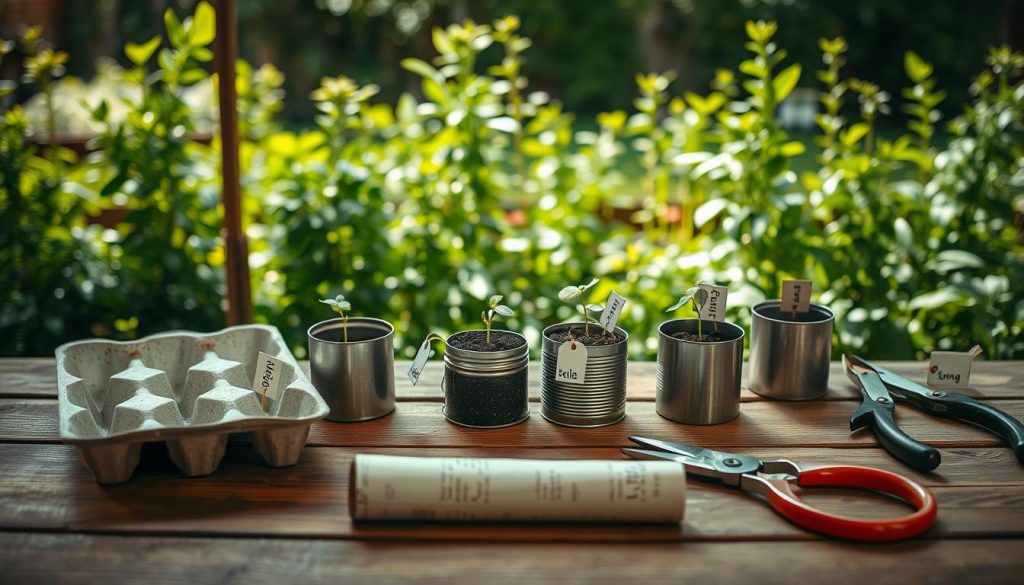
Newspaper Pots
Newspaper pots are a simple, plastic-free option for gardeners. They break down in soil, making it easy to plant seeds directly.
Folding Techniques
Begin with a newspaper sheet, cut to 10 inches wide. Fold it lengthwise around a small jar to shape your pot. Fold the bottom in for stability, then remove the jar. This origami method creates a strong, soil-holding container.
Durability Tips
Use black and white newspaper pages for stronger pots. Double-layering adds stability. Dry pots fully before adding soil. Water from below to prevent mold.
Eggshell and Egg Carton Planters
Eggshells and cardboard egg cartons are great for starting seeds. They provide a nutrient-rich environment for seedlings.
Preparation Methods
Crack eggs near the top and use the contents. Rinse and dry eggshells, then drill a hole for drainage. Use cardboard egg cartons and drill holes for each cell before adding soil.
Nutrient Benefits
Eggshells add calcium to the soil as they break down. This helps prevent blossom end rot in tomatoes and strengthens plant cell walls. Cardboard from egg cartons also adds organic matter to the soil.
Toilet Paper Roll Seedling Starters
Toilet paper rolls make biodegradable seed starters. They’re great for plants with long taproots like beans and sunflowers.
Assembly Instructions
Cut slits at one end of each roll. Fold these inward to create a bottom. Stand the rolls upright in a tray, fill with seed starting mix, and plant seeds as directed.
Moisture Management
Toilet paper rolls absorb water quickly, which can cause mold. Water from below to avoid this. Let the soil dry slightly between waterings. Plant the entire roll in the garden when ready.
| DIY Seed Starter | Materials Needed | Difficulty Level | Durability | Special Benefits |
|---|---|---|---|---|
| Newspaper Pots | Newspaper, jar or can | Easy | 2-3 weeks | Direct planting, zero waste |
| Eggshells | Empty eggshells, egg carton | Very Easy | 1-2 weeks | Calcium enrichment |
| Egg Cartons | Cardboard egg carton | Very Easy | 2 weeks | Organized planting system |
| Toilet Paper Rolls | Empty toilet paper rolls | Easy | 3-4 weeks | Ideal for deep-rooted plants |
These DIY seed starters show how to make gardening sustainable. By using these methods, you’ll cut down on plastic waste and connect more with your garden. Growing your plants in homemade containers adds a special touch to the gardening experience.
Cost Comparison: Environmentally-Friendly Seedling Trays vs. Conventional Options
When comparing eco-friendly seed starting trays to plastic ones, it’s not just about the price. Many gardeners want to be green but also watch their budget. Let’s explore how choosing eco-friendly trays can save you money while being good for the planet.
Initial Investment Considerations
Looking at seed starting supplies, you’ll see a price difference. Eco-friendly trays are often pricier than plastic ones. This can make some gardeners hesitate to choose the green option.
Price Point Analysis
Plastic trays cost $2-5 each. Eco-friendly ones, like coconut coir, range from $5-12. Peat trays might be a bit cheaper.
Paper and recycled cardboard trays are pricier, costing 1.5 to 2 times more than plastic. This is because they’re made from sustainable materials and are better quality.
Value Assessment
Eco-friendly trays are often better made. They help seedlings grow stronger and germinate better. This means healthier plants and more success in your garden.
These trays are also built to last, reducing the need for frequent replacements. Remember, you’re investing in your plants’ health and the planet’s future.
Long-term Economic Benefits
There are long-term savings with eco-friendly trays. These benefits might not be obvious at first but can really add up over time.
Reuse Potential
Many biodegradable trays can be used for years if kept dry. Coconut coir and rice hull trays can last 2-3 seasons. This makes them a smart choice for your wallet.
Even compostable trays can be reused for a second season if handled right. This extends their life and saves you money.
Hidden Cost Savings
Eco-friendly trays offer more than just a longer life. They can also improve your soil, reducing the need for expensive fertilizers. This can save you $10-15 each season.
These trays also help your seeds grow stronger. This means you waste fewer seeds and spend less on new plants. Plus, you can compost them, saving on waste disposal costs.
Considering all these points, eco-friendly seed starting trays are often the better choice. They save you money and help the environment.
How to Maximize the Lifespan of Your Eco-friendly Seed Starting Trays
Proper care of eco-friendly seed starting trays is key. It keeps your investment safe and boosts their green benefits. Sustainable trays have many advantages over plastic ones but need special care to last long. By following the right care steps, you can use your plant propagation trays for many seasons. This makes them even more eco-friendly.
Proper Care and Maintenance
Different materials need different cleaning and handling. Knowing what your eco-friendly seed starting trays need helps keep them in good shape. This ensures they work well for a long time.
Cleaning Techniques
When cleaning, think about the material of your trays. Fiber-based trays can’t handle strong chemicals like plastic ones might.
For most biodegradable trays, a soft brush to remove soil is enough. If you need to sanitize, use a diluted vinegar solution. It’s eco-friendly and won’t harm the material.
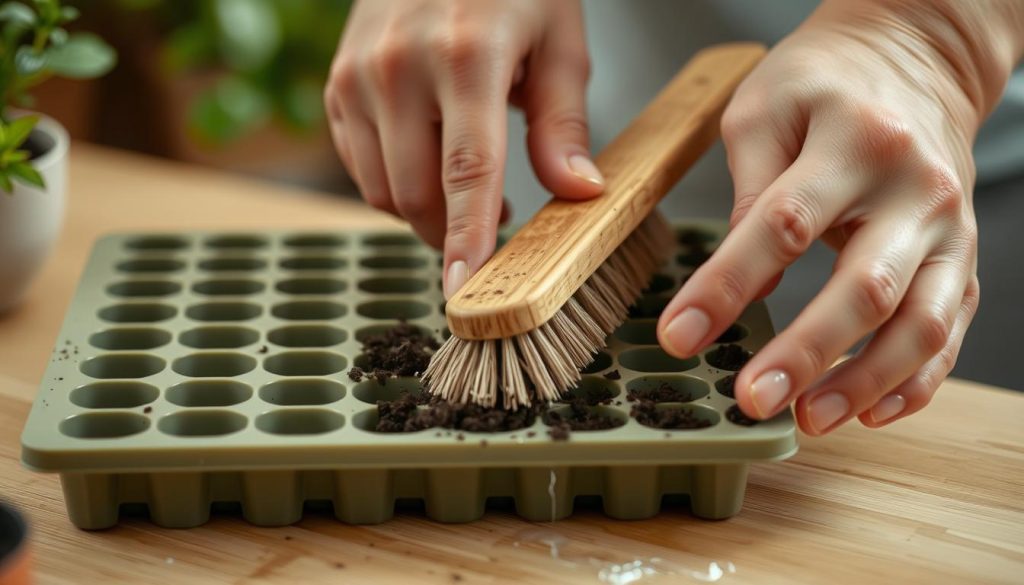
Trays made from coconut coir or wood pulp can usually handle a light water rinse. But don’t soak them for too long. For tougher options like recycled plastic or bioplastics, a hydrogen peroxide solution works well. It’s safe for the environment and cleans effectively.
| Tray Material | Cleaning Method | Sanitizing Option | What to Avoid |
|---|---|---|---|
| Paper/Newspaper | Gentle brushing | Light vinegar spray | Water soaking, scrubbing |
| Coconut Coir | Quick water rinse | Diluted vinegar solution | Prolonged moisture exposure |
| Compressed Peat | Dry brushing only | Not recommended | Any liquid cleaners |
| Bioplastic | Soap and water | Hydrogen peroxide solution | Bleach, high heat |
Handling Practices
Eco-friendly plant propagation trays are often more delicate than plastic ones. When handling, support the tray’s bottom with your palm. This spreads the weight evenly and prevents damage, like warping, when the tray is full of moist soil.
When moving seedlings, don’t pull them out of the cells. Instead, gently squeeze the sides to loosen the roots. For paper trays, you can plant the whole cell if it’s fully biodegradable. This reduces damage.
Water your seedlings carefully to avoid damaging softer materials. Use bottom watering, which is good for many eco-friendly trays. It helps the roots get enough moisture without stressing the tray.
Storage Tips for Reusable Options
Proper storage between growing seasons extends the life of your sustainable seed starting trays. With the right preparation and conditions, many eco-friendly options can last for years.
Seasonal Storage Solutions
Before storing, clean and dry your trays completely. Any leftover soil or moisture can cause damage or mold. For stackable trays, use cardboard between layers to prevent sticking and ensure airflow.
Keep your trays in a climate-controlled area to avoid damage from extreme temperatures. A garden shed, garage, or basement is usually a good choice, as long as the humidity is moderate.
Use breathable storage like cardboard boxes for natural fiber trays. This lets any remaining moisture escape, preventing damage.
Preventing Degradation
Different eco-friendly materials face different challenges. Paper and fiber trays are sensitive to moisture, so store them in the driest place possible. Adding silica gel packets to storage containers can help absorb humidity.
For trays designed to break down, keep them away from soil until you’re ready to dispose of them. Soil contains microorganisms that speed up decomposition.
UV light can weaken many sustainable materials, including bioplastics and natural fibers. Store your trays away from direct sunlight to prevent damage. With careful storage, you’ll get the most out of your investment and keep your garden sustainable.
Integrating Sustainable Gardening Supplies into Your Practice
Using sustainable gardening supplies makes your garden better for plants and the planet. Starting with eco-friendly seed trays is a good first step. Adding more green products and systems can make your garden even more effective and save you money.
Changing to sustainable gardening can be done slowly. Begin with seed trays and add more eco-friendly items as you get used to them. This way, the transition is easy and fun, not stressful.
Creating a Zero-Waste Garden System
A zero-waste garden works like nature, where nothing is wasted. It helps reduce your environmental impact and makes your garden self-sustaining. This means your garden needs less outside help over time.
Composting Used Containers
Many seed starting trays can be composted. Fiber-based ones break down easily in your compost. Just remove labels and non-compostable parts first.
For containers that need commercial composting, check with your local waste department. Some biodegradable pots need to be broken up before composting. Remember, they take months to fully decompose.
Circular gardening changes the way we garden. It uses a closed loop where everything is reused. Save seeds from strong plants and use rainwater for seedlings.
Make plant supports from pruned branches instead of plastic. Turn leaves into mulch for seedlings. These actions reduce waste and connect your garden’s parts.
Complementary Green Gardening Products
Use eco-friendly seed trays with other sustainable supplies. This keeps your garden environmentally friendly. It shows your commitment to green values.
Organic Fertilizers
Feed your seedlings with organic fertilizers for healthy soil. Compost tea is great for young plants. Just steep compost in water for 24-48 hours, then strain and use.
Commercial organic fertilizers like worm castings and seaweed extracts are convenient. They come in recyclable packaging, reducing waste. Bone meal and rock phosphate are good for transplanting, providing nutrients without chemicals.
Natural Pest Control
Use natural methods to protect your seedlings. Companion planting with plants like marigolds helps. Start these plants in the same trays as your main crops.
Diatomaceous earth keeps crawling insects away without harming the environment. Neem oil controls fungi without being toxic. These natural methods keep your garden eco-friendly all season.
Common Misconceptions About Eco-friendly Seed Starting Trays
As more people choose eco-friendly seedling trays, myths still hold them back. These myths often deal with durability and performance. Let’s look at the facts to help you choose the right seed starting materials.
Addressing Durability Concerns
Strength Testing Results
Many think compostable containers are weak compared to plastic. But, tests show they’re just as strong. Brands like coconut coir and rice hull containers pass tests well.
Another worry is how these trays handle weather. Studies prove they stay strong even in high humidity. They’re made to last in gardens and greenhouses, breaking down only when needed.
Performance Myths Debunked
Germination Rate Studies
Science shows eco-friendly trays can be just as good as plastic for seed germination. A study found paper and coconut coir trays germinate seeds as well as plastic. This is true for most plants.
Moisture Retention Capabilities
Eco-friendly trays also manage moisture better than plastic. They breathe, preventing waterlogged soil. This helps seedlings grow strong and healthy.
The design of these trays helps control moisture levels. This means you might water less often. It saves time and helps seedlings grow stronger.
Planting Seeds of Change: Why Every Gardener Should Choose Eco-friendly Seed Starting Trays
Starting a sustainable garden begins with simple choices. Choosing eco-friendly seed starting trays is one of them. It’s not just about growing plants; it’s about helping the planet.
These trays have many benefits. They cut down on plastic waste and help seedlings grow stronger. Gardeners find that plants in biodegradable containers adapt better to outdoor conditions.
While eco-friendly pots might cost more at first, they save money in the long run. You can reuse or compost them. This investment is good for your garden and the environment.
Want to start your sustainable gardening journey? Try using one eco-friendly seed tray next season. Coconut coir pots are great for tomatoes, and newspaper starters work well for herbs. Small steps can make a big difference.
Sharing your experiences with green gardening products strengthens the gardening community. Your choice to use sustainable seed trays connects you with many others. Together, we can make gardening more sustainable.
When you plant your next seeds in eco-friendly trays, you’re doing more than growing a garden. You’re helping create a sustainable future. Your seedlings and the planet will appreciate it.

